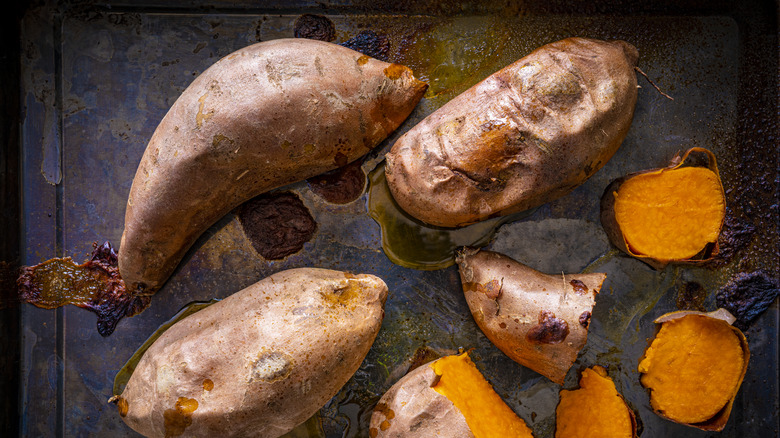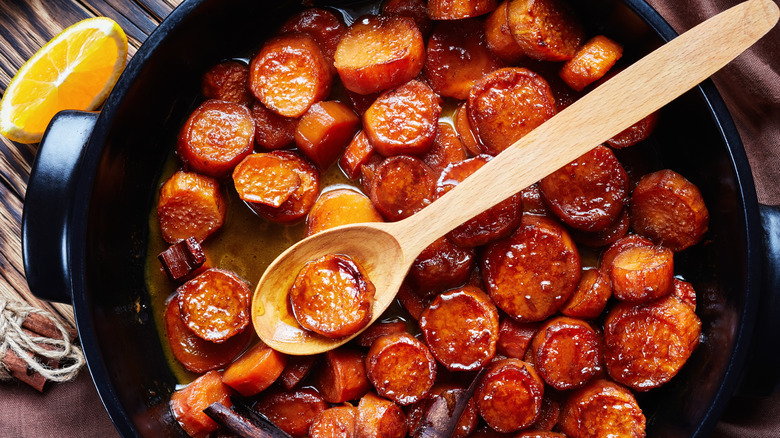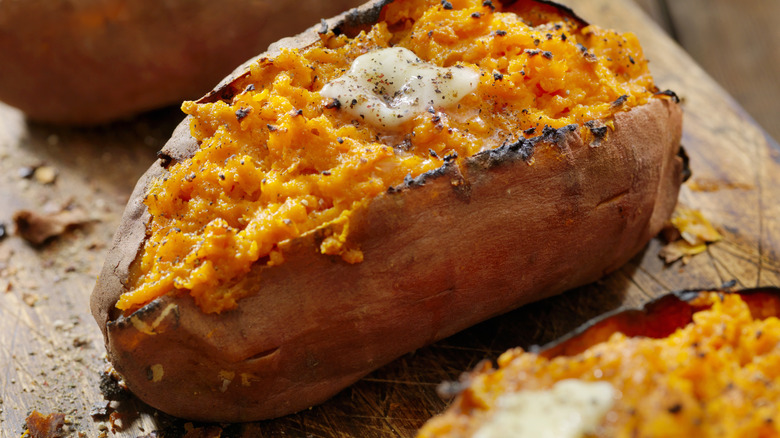The Easy Extra Step That Promises Super Crispy Roasted Sweet Potatoes
If you're like most people when given a baked sweet potato, slow-roasted and mashed in its jacket with a generous dollop of salted butter, you'll want for nothing. But — as with most other people — you can't want for something until you know it exists. So what if we told you there's one magic, easy additional step to give your roasted sweet potatoes a delectable, caramelized crisp? Anyone would say, "Shut up and tell me!" It's nothing more than this: After roasting halved sweet potatoes, place them cut side down for a few minutes in a heated, heavy-bottomed skillet with butter and (optional) honey until golden brown and crispy.
On the surface, this just makes sense, right? Sugars caramelize when heat is applied, which increases the depth of their sweetness and also forms a crisp crust. (Not to mention that butter clarifies when heated, bringing a voluptuous nuttiness to proceedings.) But if you drill down on the chemical processes underlying caramelization, things start to get vague because — let's face it — we don't fully understand what's going on. But we know a few things about the science behind the magic of cooking and, in this case, it starts with how a starchy little tuber like a sweet potato can be converted into a sugary side.
The science of making sweet potatoes sweet
If, for purely scientific reasons, you were to take a bite of a raw sweet potato, "sweet" would probably be the last word used to describe the taste. That's because they're pure starch, just like white potatoes. That changes with the application of heat because sweet potatoes have something that white potatoes don't: A particular enzyme that, when heated, converts starch into a sugar known as maltose. Maltose is the sugar typically found in grains, while sucrose and fructose come from fruits and vegetables, and lactose comes from milk. While the generalities of this chemical reaction are known, its particulars are still poorly understood.
The amount of maltose produced by sweet potatoes is controlled by time and temperature: Increased cooking time equals increased sweetness. Diced sweet potatoes that have been boiled for 20 minutes are simply not as sweet-tasting as halved ones that have been roasted in the oven for upwards of an hour. This leads us directly to that neat little post-roasting crisping technique. There is a lot of maltose on hand, so let's caramelize it in butter because, frankly, we deserve to have sweet things.
The process of super crispy caramelization
You might have heard of the Maillard reaction, the reason we can achieve a crisp crust on a flash-grilled steak. This process also requires the presence of sugars and the application of heat. But it is distinct from caramelization. So what happens when you place that roasted sweet potato half, cut side down in hot butter and honey? Essentially, moisture is removed, and carbohydrates break down into smaller molecules that then re-assemble (or polymerize) themselves into so-called volatile flavor compounds that could be described as "sweet" and "delicious." As this process continues, these polymerizations will turn various shades of colors, from light gold to an almost rusty brown before burning — at which point, congratulations, you will have chemically transformed your sweet potato into charcoal.
But if you time it right — in this case, between three and five minutes — your roasted sweet potato half will be transformed, with a crisp crust on one side and spots of golden brown. Now, anyone who eats that little treasure (adorned with various delectable toppings) could legitimately want for nothing more.


